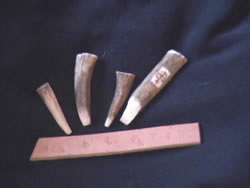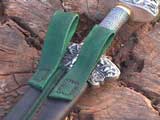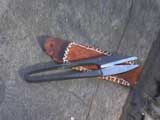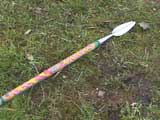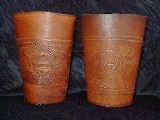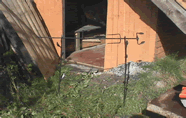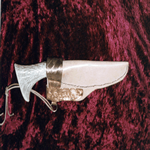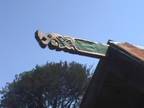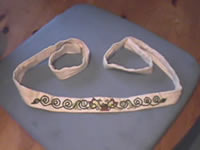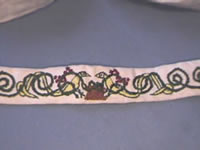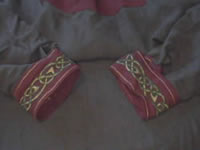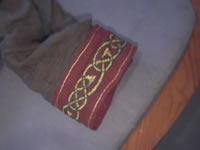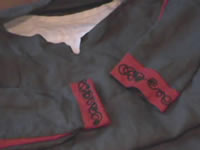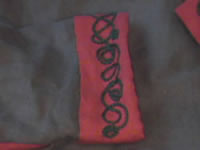Leatherwork Bone and Horn Metalwork Woodwork Textiles
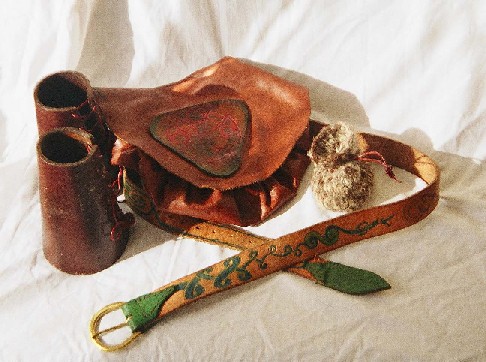
At first I shied away from working with leather due to the cost and apparent difficulty in working with it. Then I decided that I really needed to give it a go, I ordered some leather from Le Prevo and a friend taught me how to make a pair of shoes. Since then I have made many pairs of shoes, belts, scabbards and have explored the possibilities of tooling, dying painting and even a bit of tanning.
Some of my tools
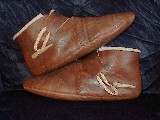
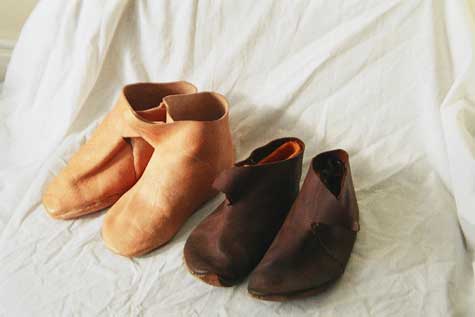
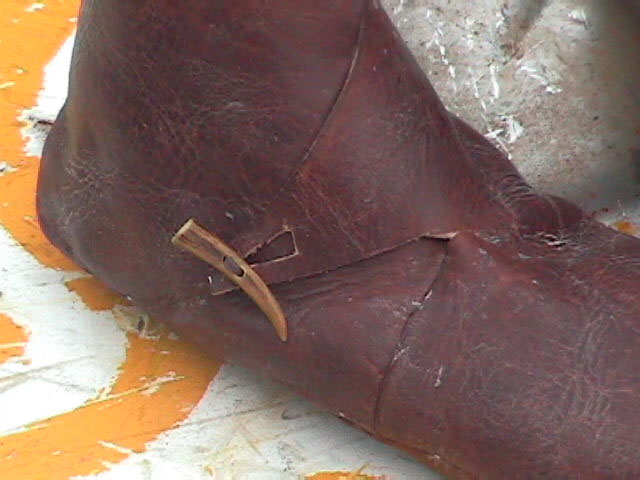



These shoes are hand stitched with blind/butt stitching and are treated with a beeswax/oil proofing.They are shown as they appear when made from natural vegetable tanned leather and died a darker brown to represent aging. Each shoe is made by adapting a general design to fit a particular persons feet, so every shoe is unique! I have made shoes with a variety of fastenings and to a number of different patterns. Customers have complimented the shoes for their comfort and durability, however they are made from natural materials which are not as waterproof or long lasting as synthetics. Sheepskin insoles and warm socks are recommended.
For an early medieval Scandinavian their knife, or saex, was as much a symbol of their status as a free man as it was a useful tool. Both the knives themselves and the scabbards used to contain them would be as highly decorated as the individual could afford. These samples of my work have been decorated with design inspired by the Oseberg ship and Borre finds in order to give the piece an early viking (circa 850AD) feel.
This is one of the first sword sheath I made. European scabbards from the early medieval period would ideally have been made from wood, lined with fleece and covered in decorated leather.The lanolin and oils in the fleece lining protected the blade form rust and the leather provided a surface to decorate in order to display the wealth of the swords owner. The leather also protected the wooden scabbard, and would be replaced when worn out allowing the scabbard to be handed down through the generations as a valued possession.
These holders for sheers are quite fun. They allow a person to keep their snips close at hand, especially when wearing clothes with no pockets. I am told they are particularly useful on fishing trips.
These items show how leather responds to pressure and moisture.
If leather is thoroughly soaked it becomes plastic and can be moulded into three dimensional shapes. When it dries it retains the shape, making it a very useful material for use in bottles, thumb guards and other pieces of armour. If it is soaked in molten wax (after being dried out!) it readily absorbs the wax and will be rock hard when it cools. Depending on the leather a range of effects and colours can be achieved using this process.
If the leather is only moistened, then it becomes possible to tool designs into it's surface. This effect can be enhanced by cutting into the leather with a sharp knife, although it is reckoned that this was not practiced in the early medieval period. These designs have therefore been tooled using only a bone stylus.
Here you have some examples of my work with bone. The buckle is a cheaper version of metal buckles with plates to attach them to the belt. The brittleness of bone is a drawback in this sort of use. Once the marrow has been cleaned from inside a bone however it makes an excellent needle case. The object in the centre of the three is based on a find from the western isles. I have used a small amount of thong and some wooden ends which were not part of the find in order to make a working case for keeping my needles in. Finally the branching tines of antler are a convenient start for making a lucet.
For all your feasting needs! This spit was fun to make. Making the leaves is a good opportunity to practice the skills required for making a spear head.
The wall in the Saxon workshop became a useful display and tool rack. When the forge wasn't in use we would cook in the same place over an open fire. On cold days, or when we were in a hurry we would use the forge to provide a little extra heat faster.
Above are photos of some of the detail on a toasting/meat fork which has seen much use!
An Antler handled knife forged for a friend, with her help. This was one of my first serious attempts to decorate the sheath using copper alloy sheet.
These rings have been hammered from bars of silver.Some of them have patterns punched in them, some are just left plain after hammering. They are modeled on the hoards of hack silver jewelry that were buried in times of trouble. They have a simple, rough, style because historically they would have been hacked into pieces and weighed out to exchange for goods or service. This did not encourage smiths to pay much attention to their design.
Wood is a readily available and friendly material to work with. I hope to post some pictures of my tool chest and the carved top plate of my set of bellows soon. Future projects include making stave buckets, and bows. One day, hopefully not too far off, I hope to build myself a boat.
I remember not liking the look of these saexes much when I first saw them. They provided a relatively inexpensive source of materials for practicing my carving on though. I think I received this one as part of a barter arrangement for modifying a byrnie
For more images from the saxon style house we built you can look in the projects page. The house itself was more of an experiment in construction techniques that an attempt to create an exact replica. It did give me an opportunity to try out some larger scale woodworking however, and this dragons head looked particularly effective when the sun warmed the gold and green paint at sunset. The dragons head itself is designed with reference to the late ninth century stone cross at Kirk Michael on the Isle of Man.
Long braids can be used to decorate the edge of shirts, or even as belts. They are woven using cards (or tablets - hence tablet weaving) made from wood or bone. These cards control the warp of the weave and as they are turned forwards or backwards new sections of the warp become the surface. The cards can be turned individually, or together. This allows the weaver a great deal of control over the pattern. Using a second weft thread can increase this control, as the structural integrity of the weave is maintained by the primary weft.
I have also recently been experimenting with embroidery, mostly this is because I needed some Saxon Kit for the battle of Hastings in 2006





